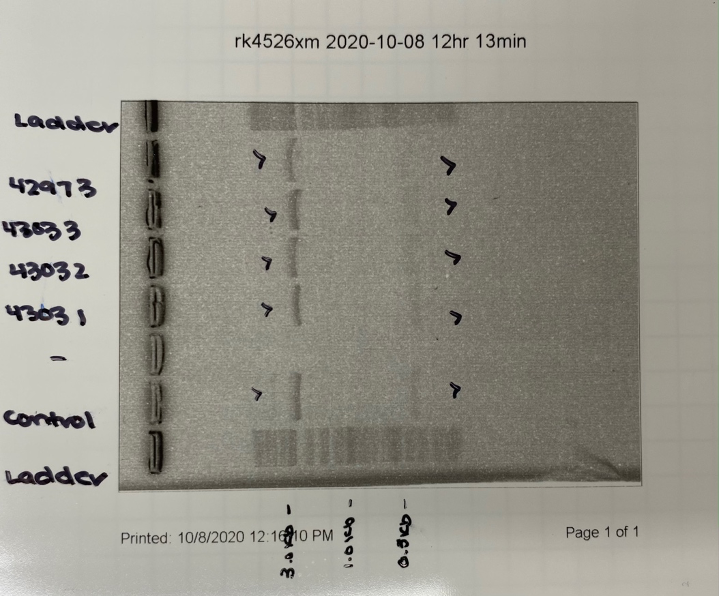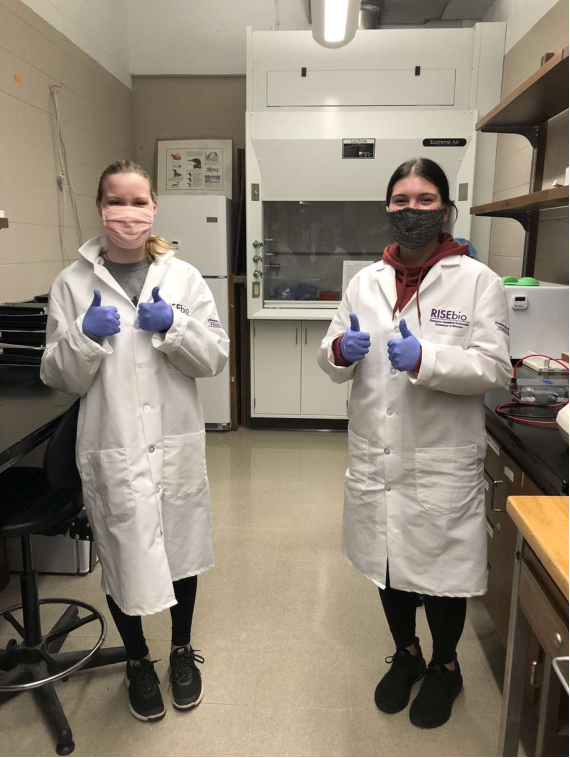By: Emilie Greene and Taylor Forstner
November 10, 2020
Introduction:
Welcome to our final blog post. With only two weeks left in the lab, we are wrapping up our research with our last few protocols and preparing to present our results. Since our last blog post, we have had some highs and lows with our research. Despite some setbacks and a limited lab schedule due to COVID-19, we have still made great progress. Since our last blog post, we were able to complete a successful bacterial transformation with E. coli. and in the past few weeks, we have been working with our miRNA amplicons.
Research:
In our last blog post, we were unsuccessful in performing a bacterial transformation. After multiple attempts, we found out that the pcDNA3.1 that we were using had degraded. After switching the pcDNA3.1 to pMiniT, we had success. We were then confident that we could use our miRNA’s moving forward. Through ligation, we inserted our purified miRNA-4303 and miRNA-4297 PCR product into a pMiniT vector and then transformed E. coli with these plasmids. We let these bacteria grow on plates overnight and then inoculated 12 individual colonies from each miRNA into LB-Amp broth to isolate individual populations. The next step was to take four of these bacterial samples and isolate their plasmid DNA and determine the concentration of the DNA extracted. For miRNA-4303, we saw high concentrations for three of the four samples, but for miRNA-4297 we only saw one. With the samples that had good concentrations, we still had to see if our miRNA amplicons were successfully inserted into the plasmids. We ran the samples through a restriction digest to cut our miRNA back out. If our miRNA was in the plasmids we should see two clear bands and the correct sizes, which we saw!

Being that we saw good results, we could then send in our samples for sequencing. Sequencing allowed us to compare our miRNA amplicons’ code to the predicted code we found at the beginning of our project. For miRNA-4303 it was a perfect match with good purity! But for miRNA-4297 we still saw good purity but had a singular base pair mismatch. A singular mismatch could be because of natural variation in genotype, or it could have been an error made by DNA polymerase during PCR. Being that we only had one sample for miRNA-4297 we wanted to get more samples to sequence to determine the cause so we took the rest of our bacterial samples from the transformation and tried to isolate their DNA, but still saw concentrations that were too low to sequence. Moving forward we just used the one sequences 4297 sample and made a note to later go back and try to sequence more of the miRNA.
Taking the samples we sequenced, we ran them through another restriction digest to remove them from the pMiniT and insert them into pcDNA3.1. We ran this restriction digest on a gel but saw no bands where our miRNA was supposed to be. Unfortunately, because of time constraints, we had to abandon these samples and go back to getting new samples to sequence for miRNA-4297.
Now we are performing more ligations and transformations for miRNA-4297 hoping to get good enough DNA concentrations to sequence and determine why we had a one base pair mismatch.

Conclusion:
We are sad to be finishing our projects and saying goodbye to the RISEbio research lab but we are so grateful for the friends we made and the experiences we got to have because of this program. We are now both interested in continuing undergraduate research and are confident in our ability to do well in a research environment thanks to the skills we learned in RISEbio. We want to thank Dr. Land, Courtney, Kaela, Amyah, and the rest of our stream for helping us along the way and making this opportunity so amazing. We are extremely proud of how far we have come and how much progress we have made even with a world pandemic holding us back.
- Emilie & Taylor

